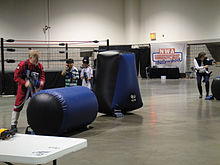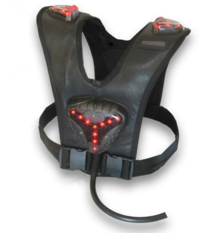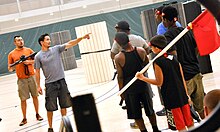Laser tag
 From Wikipedia - Reading time: 8 min
From Wikipedia - Reading time: 8 min
This article needs additional citations for verification. (December 2021) |
Laser tag is a recreational shooting sport where participants use infrared-emitting light guns to tag designated targets. Infrared-sensitive signaling devices are commonly worn by each player to register hits and are sometimes integrated within the arena in which the game is played.[1]
Since its birth in 1979, with the release of the Star Trek Electronic Phasers toy manufactured by the South Bend Electronics brand of Milton Bradley, laser tag has evolved into both indoor and outdoor styles of play, and may include simulations of close quarter combat, role play-style adventure games, or competitive sporting events including tactical configurations and precise game goals.
Laser tag is popular with a wide range of ages. Laser tag tournaments are staged for local, regional/state, inter-regional, national, bi-lateral international, and international levels.
History
[edit]In late 1970s and early 1980s, the United States Army deployed a system using lasers for combat training. This MILES system functioned like laser tag in that beams are "fired" into receivers that score hits.[2]
The first known toy to use infrared light and a corresponding sensor was manufactured and marketed in 1979 as the Star Trek Electronic Phaser Guns set to accompany the release of Star Trek: The Motion Picture.[3]

In 1982, George Carter III began the process of designing an arena-based system for playing a scored version of the game, a possibility which had initially occurred to him in 1977 while watching the film Star Wars. The Grand Opening for the first Photon center was in Dallas, Texas on 28 March 1984.[4] Carter was honored by the International Laser Tag Association on 17 November 2005 for his contribution to the laser tag industry. The award is engraved "Presented to George A. Carter III in recognition for being the Inventor and Founder of the laser tag industry".[5]
In 1986, the first Photon toys were sold, nearly simultaneously with the Lazer Tag toys from Worlds of Wonder and several other similar infrared and visible light-based toys. Worlds of Wonder went out of business around 1988, and Photon soon followed in 1989, as the fad of the games wore off. Today there are laser tag arenas all over the world bearing various names and brands, as well as a large variety of consumer equipment for home play and professional grade equipment for outdoor laser tag arenas and businesses.[6]
In March 2009, upon the Winnenden school shooting, the German government announced that it would ban games such as laser tag and paintball, claiming that they trivialize and encourage violence. It later retracted this assertion.[7]
In 2010, a news article appeared claiming that Lee Weinstein developed and opened the first commercial laser tag facility. In June 2011, the ILTA posted the results of a public record request from the City of Houston showing the opening date for Weinstein's "Star Laser Force" to have been 16 April 1985.[8]
Equipment and technology
[edit]

Laser tag systems typically use infrared signaling to track firing of the beam. In indoor play, a visible light combined with theatrical fog typically provide the visual effect of firing, while having no actual role in transmitting the fire signal. Despite the name, laser tag equipment does not fire lasers, due to the potential dangers involved.[9] Some laser tag may use additional equipment to simulate control points, respawn boxes, portable med kits, landmines, grenade launchers and hand grenades.[10]
See also
[edit]References
[edit]- ^ "How do Laser Tag Guns and Sensors Actually Work?". interestingengineering.com. 8 December 2019. Retrieved 2 December 2021.
- ^ Multiple Integrated Laser Engagement System, the Federation of American Scientists Military Analysis Network, accessed 13 November 2006
- ^ TagFerret's Laser Tag History Page, a historical reference to consumer laser tag product from a toy industry insider.
- ^ "Anniversary". Lasertagmuseum.com. 28 March 2014.
- ^ "Georgte Carter III Joins ILTA Board". Archived from the original on 20 July 2011. Retrieved 14 May 2011.
- ^ History of Laser Tag Archived 23 September 2006 at the Wayback Machine, International Laser Tag Association, accessed 17 September 2006
- ^ "Germany moves to outlaw paintball". BBC News. 9 May 2009.
- ^ "History of the laser tag industry". Laser Tag Museum. Retrieved 29 April 2014.
- ^ "No Real Lasers in Laser Tag aka Lazer Tag".
- ^ "Czym jest laser tag? > Wielka Spluwa". Archived from the original on 30 August 2018.
 KSF
KSF